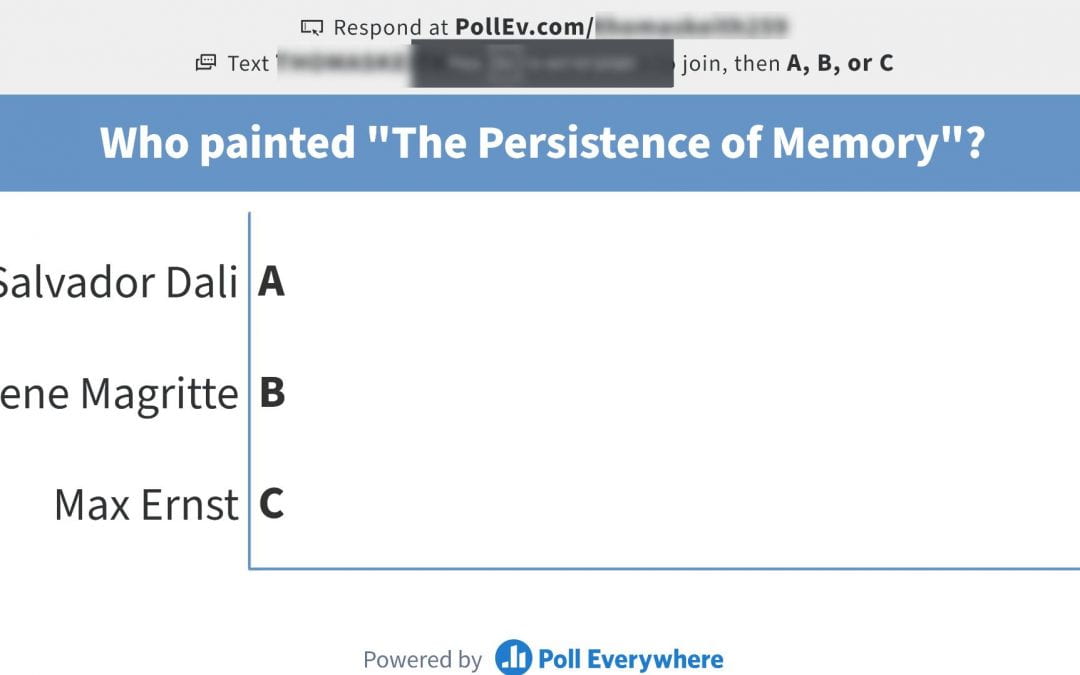Matt Teichman, former Lecturer in Humanities, used Poll Everywhere to promote student engagement in his seminar-style “Language and the Human” course. He had his students come up with poll questions themselves and then used them as prompts at the beginning of student-led discussions to generate interest and get other students engaged.

Matt Teichman
The Problem
What do you do if you’re staring at a group of shy, unresponsive students? This happens all too often in the classroom. And as the lesson goes on, it seems they draw farther into their shells instead of warming up. This was a particular problem for Matt’s Language and the Human class. Unlike many other Humanities Core classes, Language and the Human is co-taught by nine instructors from various disciplines. One day a week, all ten sections met together for a lecture, and a different instructor would give the lecture for that week. Then later in the week each section of approximately 18 students would meet separately to have a discussion about the lecture. These discussions were to be led by students in the section. Getting students to discuss is hard enough, but getting students to lead a discussion is exponentially harder!
The Tool
Here, Matt Teichman leveraged Poll Everywhere to help students answer some questions and engage in group discussions. It allowed him to apply various pedagogical methods such as active learning, collaborative learning, and primarily engaging class discussion.
Poll Everywhere is the University’s student polling solution. It is a tool for engaging students, gathering responses, reviewing answers, and real-time polling. Since it is not hardware-based, it can be used with any internet-enabled device. It integrates with laptops, tablets, and smartphones. It can also export poll answers back into Canvas, allowing you to incorporate it into your class grades. Poll Everywhere offers live, real-time classroom audience polling capabilities. Furthermore, Poll Everywhere does not require students to buy expensive physical clickers, since it leverages web-based software. You can use it from anywhere in the world as long as you have a stable internet connection.
The Exercise
Matt had implemented some mechanisms which helped to keep the discussion from becoming completely unstructured. For example, the student discussion leaders reviewed their ideas with him and revised them as needed before class began. He also asked them to base their proposed topics on the issues that other students posted in the Canvas discussion board between the lecture and the discussion section. During the discussions, whenever students got off topic or became quiet he would intervene in the discussion to steer it back on course.
Students who were leading discussions would also review the types of poll questions they wanted to ask, the poll types they wanted to use for each question, and the timing of the poll questions. Students often used multiple choice questions, word cloud questions, image-based questions, and Q&A-style questions that allow other participants to vote options up and down.
Matt states:
“This is where I have found online polls to be incredibly useful. Hum Core students are freshmen, and are often still in the process of working through what they’re even doing in college, let alone how they might try to teach college. If I tell a timid young person to rigorously cover challenging academic material in a course session they planned… …they’re likely to look at me like a deer in headlights. But if I tell them to pick their six favorite things someone said on Canvas and come up with fun poll questions to ask everyone… …suddenly the task of planning a course session feels a lot more doable.”
The Results
Compared to previous years in which he taught without Poll Everywhere, Matt saw a significant increase in the engagement students showed in their discussions. He states:
“And before we know it, we’ve got a room full of people enthusiastically sharing their views on the course material —including the shy ones. The polls give the student discussion leaders a hassle-free way to open up a new topic of discussion without having to come up with a clever segue. Doing things this way increases student engagement in the class, drawing participation from everyone, rather than just the talkative students.”
There was almost always an engagement bump after the poll questions. Surprisingly, students were happy to share how they voted on a question, and furthermore, they followed up by explaining why they voted that way. Also, when poll questions were left open, they would change their responses during a discussion, so there were some real time sentiment displays.
Matt hopes that his use of Poll Everywhere will encourage instructors to broaden their idea of what counts as class participation, and in turn gets more students from diverse backgrounds involved.
“Participating in an anonymous poll gives students another way to direct the flow of conversation in class, other than the classic ‘raise your hand and make a scintillating observation’ model. Technology is developing at such a mind-boggling rate, it’s hard to know everything that new developments can achieve in the classroom. But our initial experiments with Poll Everywhere have proven quite promising, in my estimation.”
Using Polling Software at UChicago
During the pilot phase, faculty successfully leveraged the engagement strategies above and used Poll Everywhere to start off student discussions, to review for quizzes, to gather student questions about difficult problems, and, of course, to get to know their students better. Faculty have used Poll Everywhere:
- In small classrooms
- In large classrooms
- Outside the classroom
More Information about Poll Everywhere
- For more information, please see our Poll Everywhere site.
- To get started with Poll Everywhere please visit the Get Started page.
- Poll Everywhere Faculty Discussion, 2021 Winter
- Poll Everywhere Session at Symposium for Teaching with Technology 2019

